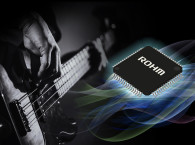
With over 50 years of expertise, ROHM offers a range of high-fidelity processors and premium audio power ICs, that are all key to audio equipment quality. ROHM's latest product builds upon the first-generation MUS-IC BD34301EKV DAC, renowned for its sound quality that lead to the adoption in high-end designs from many brands. The new BD34302EKV inherits the core design concept behind ROHM's DAC chip and emphasizes the natural elements of sound from the MUS-IC series, for an even more realistic audio experience.
By incorporating a new algorithm for data-weighted averaging (DWA), the BD34302EKV converter achieves a THD+N characteristic of -117dB (THD: -127dB), a key performance indicator for sound quality. In addition, the signal-to-noise ratio (SNR) of 130dB provides a noise performance befitting a flagship DAC chip, while a sampling frequency of up to 1,536kHz allows developers to fully leverage the high-precision calculations of their digital signal processors (DSPs).
A digital FIR filter (Sharp Roll Off/ Slow Roll Off) is available and the new DAC can be configured for stereo, mono, or HD monaural current output modes, with multi-bit ⊿Σ data input support. An automatic mode switching function makes it possible to easily switch between PCM/DSD and different sampling frequencies.

ROHM's proprietary HD (high definition) monaural mode allocates one DAC chip per channel and contributes to a smoother, more natural sound. “As part of our MUS-IC series, uncompromising craftsmanship has been applied down to the smallest details. Based on years of expertise in sound quality design, the optimal bonding wire material for each terminal of the BD34302EKV was selected to accurately convey the natural "texture" of musical instruments. These features help create the ideal sound sought by high-end audio manufacturers,” the Kyoto-based company states.
ROHM is a leading semiconductor and electronic component manufacturer established in 1958 and supplies ICs, discrete, and electronic components to the automotive, industrial, consumer, and communication markets. The company’s strengths in the analog and power markets allow it to propose optimized solutions for entire systems that include peripheral components (transistors, diodes, resistors, etc), power devices such as SiC and GaN, and drive ICs that maximize their performance. From the analog audio era of the 1970s to today’s digital circuits, ROHM’s engineers have perfected a range of audio ICs that always aimed to push the numerical values and sound quality performance required in an audio device to the utmost limits.
www.rohm.com







